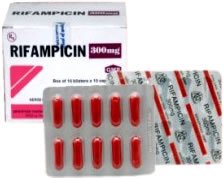
Rifampicin, also known as rifampin, is an antibiotic used to treat several types of bacterial infections, including tuberculosis, leprosy, and Legionnaire's disease. More
Rifampicin, also known as rifampin, is an antibiotic used to treat several types of bacterial infections, including tuberculosis, leprosy, and Legionnaire's disease.
Rifampicin or rifampin
Rifampicin; Rifadin; Rifampin; Rimactane; Rifampicinum; Rifaldazine
Coxid-450, Coxkit- 3, Eufacin, Famcin, Kemorifa, Ls-Rif, Macox, Monocin, Montomycin, R-Cin, Rifacept, Rifacilin, Rifampila, Rifamycin, Rifaplus CAPS, Rimactane, Rimpacin, Rimpin, Ripharmed, Scc-2, Taurif, Ter-4, Ticin, Zucox
(7S,9E,11S,12R,13S,14R,15R,16R,17S,18S,19E,21Z)-2,15,17,27,29-pentahydroxy-11-methoxy-3,7,12,14,16,18,22-heptamethyl-26-[(1E)-[(4-methylpiperazin-1-yl)imino]methyl]-6,23-dioxo-8,30-dioxa-24-azatetracyclo[23.3.1.1?,?.0?,²?]
89% protein binding.
This is acted via the inhibition of DNA-dependent RNA polymerase, and then leads to the suppression of RNA synthesis and cell death.
The recommended dosage is 10 mg/kg/day or 2-3 times/week. Max: 600 mg/day per oral.
For the treatment of Tuberculosis and Tuberculosis-related mycobacterial infections.
Thrombophloebitis; fatalities in those with liver disorders, influenza- like symptoms, skin reactions, eosinophilia, transient leucopenia, thrombocytopenia, purpura, abnormalities of liver function, shock, drowsiness, headache, ataxia, visual disturbances, menstural irregularities. Reddish coloured urine & tears. Hepatitis or shock like syndrome with hepatic involvement.
Hypersensitivity, jaundice, severe hepatic disease. IM/SC admin. Porphyria. Not to be used for treatment of meningcoccal disease.
Store it at room temperature.
822.9402
C43H58N4O12
13292-46-1